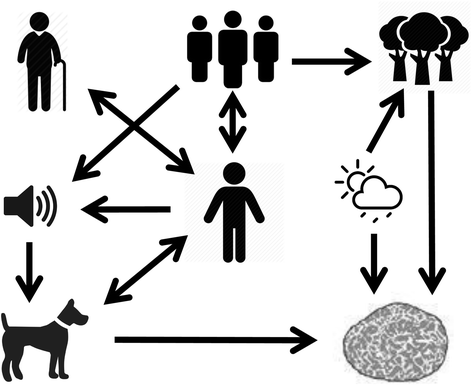The changing ethnoecological cobweb of white truffle (Tuber mangnatum Pico) gatherers in South Piedmont, NW Italy
- PMID: 27091474
- PMCID: PMC4836152
- DOI: 10.1186/s13002-016-0088-9
The changing ethnoecological cobweb of white truffle (Tuber mangnatum Pico) gatherers in South Piedmont, NW Italy
Abstract
Background: Traditional Environmental Knowledge (TEK) related to truffles represents an under-investigated area of research in ethnobiology. Nevertheless, truffles, in a few southern European areas, and notably in South Piedmont, represent a crucial component of the local economy and cultural heritage.
Methods: Thirty-four white truffle (Tuber magnatum Pico) gatherers, locally known as trifulau, aged between 35 and 75 years and living in a few villages and small towns of the Langhe and Roero areas (South Piedmont, NW Italy), were interviewed in-depth during the years 2010-2014 regarding their ecological perceptions, truffle gathering techniques, and the socio-ecological changes that have occurred during the past several decades.
Results: A very sophisticated ethnoecological knowledge of the trees, soils, and climatic conditions considered ideal for searching for and finding white truffles was recorded. Moreover, a very intimate connection between gatherers and their dogs plays a fundamental role in the success of the truffle search. However, according to the informants, this complex ethnoecological cobweb among men, truffles, dogs, and the environment has been heavily threatened in the past few decades by major changes: climate change, in which the summer has become a very hot and dry season; social changes, due to a more market-oriented attitude of younger gatherers; and especially environmental and macro-economic dynamics, which followed the remarkable expansion of viticulture in the study area.
Conclusion: The TEK of white truffle gatherers indicates the urgent need for fostering sustainable gastronomy-centred initiatives, aimed at increasing the awareness of consumers and food entrepreneurs regarding the co-evolution that has inextricably linked locals, truffles, and their natural environment during the past three centuries.
Keywords: Ethnoecology; Ethnomycology; Italy; Piedmont; Truffles.
Figures
References
-
- Forum for Food Sovereignty. Declaration of Nyéléni. 2007. http://nyeleni.org/IMG/pdf/DeclNyeleni-en.pdf. Accessed 9 Jan 2016.
-
- Nolan JM, Pieroni A. Introduction to special issue on food security in a changing world. J Ethnobiol. 2014;34:4–6. doi: 10.2993/0278-0771-34.1.4. - DOI
-
- Bourdeaux Q, Buyck B, Malaisse F, Matera J, Marlier M, Wathelet B, Lognay G. Wild edible mushrooms from a Zambezian woodland area (Copperbelt Province, Zambia) Geo-Eco-Trop. 2003;27:33–44.
-
- Jarvis MC, Miller AM, Sheahan J, Ploetz K, Watson RR, Ruiz MP, Pascario Villapan CA, Alvarado JG. Edible wild mushrooms of the Cofre de Perote region, Veracruz, Mexico: An ethnomycological study of common names and uses. Econ Bot. 2004;58:S111–S115. doi: 10.1663/0013-0001(2004)58[S111:EWMOTC]2.0.CO;2. - DOI
MeSH terms
Substances
LinkOut - more resources
Full Text Sources
Other Literature Sources
Medical
Miscellaneous




